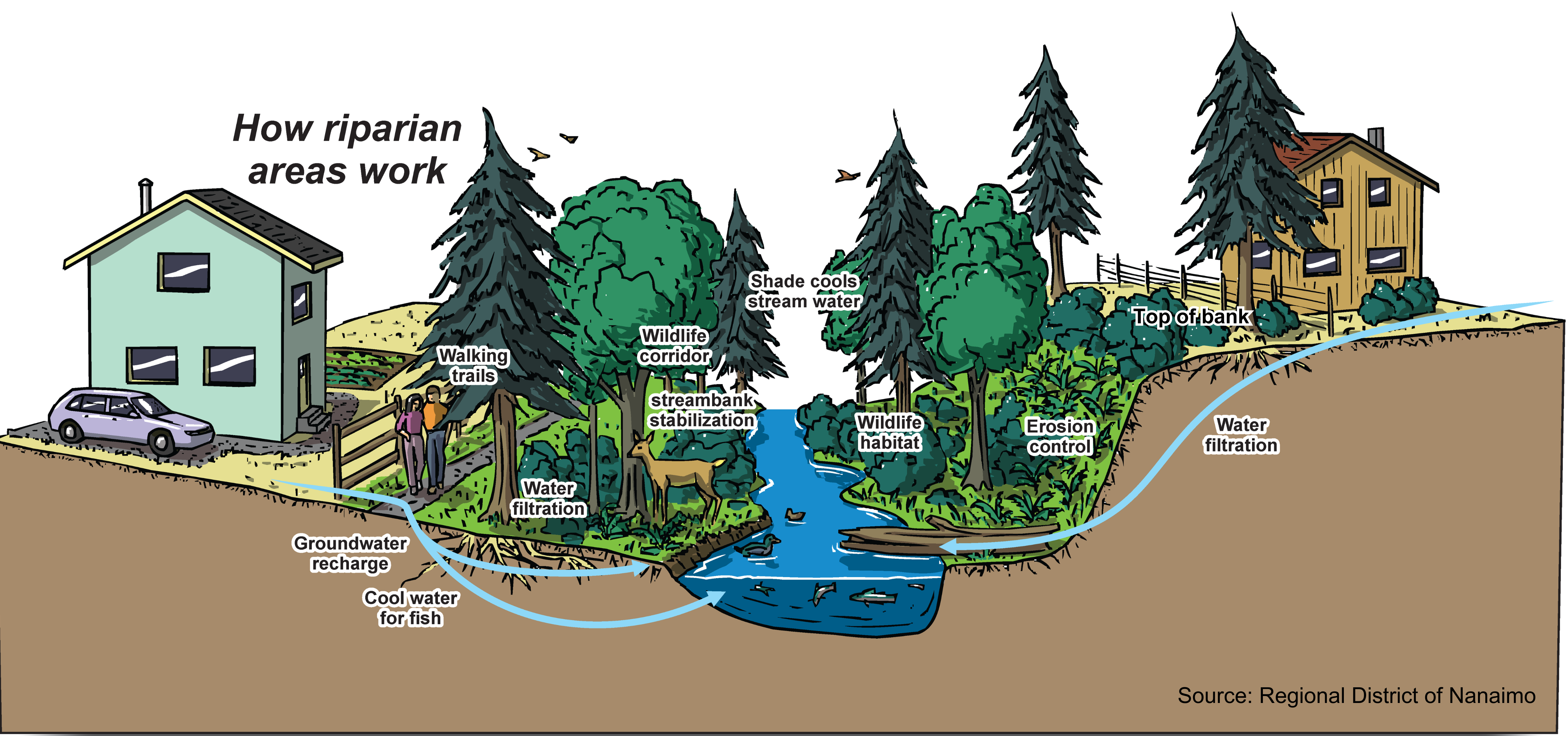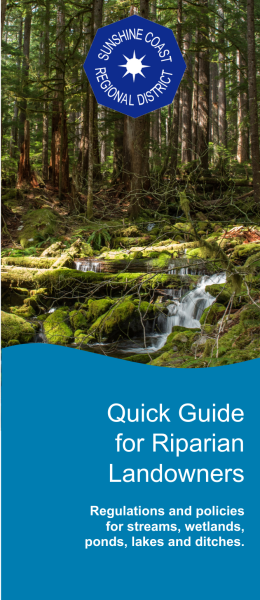Stream and Riparian Protection
What are Riparian Areas?
Riparian areas are the lands beside water, the “in-between” places that link aquatic and terrestrial habitats. Watercourses include creeks, rivers, ditches, ponds, swamps, wetlands, and lakes, whether natural or human made.
Riparian areas are important transition zones between the land and the water. The trees, plants, and woody debris within a riparian area shade the water, provide food and habitat for fish and wildlife, stop stream banks from wearing away, purify rainwater, and help slow water runoff. A riparian area may or may not be wet in all seasons.
Before you start any land alteration within 30 metres of a watercourse or the top of a bank, be sure to contact local and provincial authorities for rules and regulations. Approvals are needed from both the Sunshine Coast Regional District (SCRD) and the Province prior to any land alteration.
Contact Planning staff at planning@scrd.ca

Frequently Asked Questions
Riparian areas are the lands beside streams, lakes, wetlands and ditches, that link aquatic and terrestrial habitats. Riparian areas are important transition zones between the land and the water. The trees and plants within a riparian area shade the water, provide food and habitat for fish and wildlife, reduce streambank erosion, filter stormwater run-off, and protect water quality.
Within the SCRD, riparian areas are protected from development and land alteration. Before you develop or do work within 30 metres of a watercourse (creek, river, ditch, pond, swamp, wetland, and lake, whether natural or human made), be sure to contact local and provincial authorities for rules and regulations.
Riparian areas are vital for biodiversity, water quality, flood prevention, soil stability, and providing habitats and nutrients for various species of fish and wildlife. These benefits are why riparian areas need to be assessed by a professional before any land alteration can take place within a riparian area or near a waterbody.
Yes, Riparian Area Protection Regulations apply to all landowners for residential, commercial or industrial uses.
The Riparian Areas Protection Regulation (RAPR) was enacted under Section 12 of the Fish Protection Act in July 2004. The Fish Protection Act was subsequently re-titled the Riparian Areas Protection Act in February 2016. The act and regulation call on local governments to protect riparian areas during residential, commercial, and industrial development by ensuring that a Qualified Environmental Professional (QEP) conducts a science-based assessment of proposed activities.
Note: The former Riparian Areas Regulation (RAR) was amended on November 1, 2019, and became the Riparian Areas Protection Regulation (RAPR). This regulatory change means that any Streamside Protection and Enhancement Areas (SPEAs) established before November 1, 2019, need to be reassessed if and when any proposed development or land alternation is proposed within the 30 metres riparian assessment area.
Qualified Environmental Professionals (QEPs) include agrologists, biologists, foresters, geoscientists, and technologists who are in good standing with their respective professional organizations working in their area of expertise. QEPs understand what makes up a properly functioning riparian area.
A QEP is tasked with assessing the waterbody on your property to understand its role in providing for fish habitat, even if it does not actually contain fish itself. The QEP will establish a Stream Protection and Enhancement Area (SPEA) where no land alteration or building is permitted. If human impacts have compromised a riparian area, the QEP will prescribe measures to remediate the impacted area to a state that is as natural as possible and make recommendations to protect that area.
RAPR defines ditches, whether or not they usually containing water, a stream and therefore requires a RAPR Assessment by a Qualified Environmental Professional. Ditches and culverts can be connected to fish habitat, and in turn provide them with nutrients.
Stream Protection and Enhancement Areas (SPEAs) are undevelopable areas where no land alteration (building, tree cutting, vegetation removal, hardscaping, etc.) is permitted. The SPEA is a result of a RARP Assessment, completed by a Qualified Environmental Professional (QEP), and can range in size depending on aspects such as size, environmental value and proposed uses, as determined by the QEP.
While the following activities are permitted under the Riparian Area Protection Regulation (RAPR), it is best to check in with SCRD Planning Staff before conducting the activities as they may require an SCRD Development Permit or Tree Cutting Permit.
- Remove invasive plants for the purposes of habitat restoration.
- Plant native plants
- Remove trees that are deemed to be hazardous by a Certified Arborist (SCRD Tree cutting permit required)
- Construct buildings or structures (e.g., gazebo, deck, shed, septic field, pool, retaining walls, etc.)
- Install non-structural impervious or semi-impervious surfaces (e.g., driveways, patios, sidewalks, gravel walking path, etc.)
- Construct roads, trails, docks, wharves, or bridges
- Install flood protection works
- Install sewer or water services
- Install drainage systems or utility corridors
- Remove, deposit, or disturb soils
- Remove, alter, disrupt, or destroy native vegetation (including trees, shrubs, and understory plants)
- Plant ornamental (i.e. non-native) plants or allow non-native plants from your garden to spread into the SPEA
- Allow your pets to utilize the area with enough frequency that they impact vegetation through trampling
- Use pesticides, unless they are for removing invasive plants and prior permission is given by the SCRD and Province
- Store any equipment, materials, etc.
- Place recreational or play structures (e.g., trampolines, swing-sets, fire rings/pits, etc.)
- Dispose of garbage or yard waste
- Use motorized vehicles (e.g., dirt bikes, ATVs, etc.)
SCRD Bylaw Enforcement Officers ensure that the SCRD bylaws are adhered to. If you have a complaint regarding a violation of a bylaw, please fill out the Complaint Form. Complaints will only be invested if a fully complete form is submitted.
Complaints about habitat impacts that are in progress and do not involve development such as:
- Illegal waste disposal, such as household or business waste and waste dumped on Crown Land
- The discharge of chemicals or sewage to lakes or rivers
- Damage to fish or wildlife habitat
Call 1-877-952-7277 (RAPP). If the situation is not an emergency, report the incident online or contact the nearest Conservation Officer Service district office.
For fisheries violations related to salmon, contact Fisheries and Oceans Canada (DFO) at 1-800-465-4336.
Property owners can face significant financial penalties for altering land within the Riparian Assessment Area without permits/approval from the province and SCRD.
Penalties from the SCRD can include tickets from Bylaw Enforcement Officers up to $1,000 per day until compliance is reached. Further, the BC Offence Act permits a person who is convicted of an offence is liable to a fine of not more than $2,000 or to imprisonment for not more than 6 months, or to both.
The SCRD works closely with property owners to bring their properties back into compliance through warning, ticketing and retroactive Development Permits. Property owners must ensure that the process moves forward in a timely fashion, otherwise, further bylaw enforcement measures will occur.
Retroactive development permit and approvals process is required when work has been done in the Riparian Assessment Area without appropriate approvals. At minimum a property owner would need to hire a Qualified Environmental Professional (QEP) to work with the SCRD and Province to address the humans impacts on the riparian area. If works occurred within the water, additional Provincial and Federal agencies would likely be involved in the remediation process.
Broadly speaking, there are three key stages to the retroactive development permit process:
First involves understanding the development / land alteration that took place and assessing the impact. This stage includes an assessment of the infraction on your property to understand the severity of the impacts on the riparian area. A remediation, or “REM” application is opened with SCRD.
Second is the Development Permit stage. The purpose of the Development Permit is to actually permit activities within the riparian area, approved by the Province and SCRD. Activities include implementing remediation measures in the riparian area, and establishing a new protection area or buffer for the riparian area to help mitigate further human impacts.
Third is the actual remediation and protection work within the riparian area, which is overseen by a Qualified Environmental Professional.
Please note – Landowners and their QEP must ensure that the process moves forward in a timely fashion, otherwise, bylaw enforcement measures will occur.
The Riparian Assessment Area is the land within 30 metres of a waterbody high water mark, and if the waterbody is in a ravine, this area could be much larger. If your land alterations are outside this area, it is your responsibility to prove this through a survey or Qualified Environmental Professional (QEP) letter. Surveyors and QEPs should be familiar with the Riparian Area Protection Regulation (RAPR) in properly establishing the Riparian Assessment Area (RAA).
Resources
How you manage your property directly impacts stream health, fish, and wildlife.
- SCRD Quick Guide for Riparian Landowners
- SCRD Development Permit Areas
- Provincial Riparian Areas Regulation Webpage
Your development or land alteration may also be governed by or require review under one of the following provincial or federal acts or regulations. Contact a Qualified Environmental Professional (QEP) for more information.
Disclaimer: This content is a summary of the SCRD’s Bylaws and Guidelines. It is not legal advice and does not provide an interpretation of the law. In the event of any conflict or difference between this webpage and the bylaws or guidelines, the bylaws or guidelines are correct and legal and must be followed.
